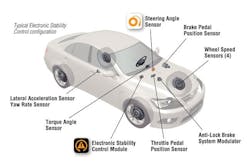Electronic Stability Control Adds New Elements—and Liability—to Repair Process
Electronic Stability Control (ESC) is becoming prominent in today’s vehicles because “studies prove it can reduce accidents and save lives,” says Denny Bowen, director of product management for Hunter Engineering. In 2004, the National Highway and Traffic Safety Administration (NHTSA) concluded that ESC reduces crashes by 35 percent.
Repairers need to understand the ESC component because it adds another step in the repair process in order to send customers home with a complete and safe repair.
Your technicians need to know about ESC—and how to deal with it—because there are nearly 25 million cars on the road today that have ESC. If this is new to you, now is the time to get in the know. NHTSA issued a mandate in 2006 that requires all vehicles manufactured in the U.S. and weighing up to 10,000 pounds to be equipped with the component by 2012.
Repairer Implications
ESC relies on accurate steering input from the steering angle sensor to analyze driving situations, and apply the appropriate measures to help direct the vehicle on the driver’s intended path. It’s the steering angle sensor that tells the vehicle’s computer the position of the steering wheel at any given time, and what direction the vehicle is traveling.
If a vehicle has incurred any structural, steering or suspension damage, that could potentially affect the vehicle’s wheel alignment or sensor calibration, says Jeffrey Poole, performance training coordinator for I-CAR. Repairers then have to identify whether there’s been an effect on the ESC system.
Whenever you make a change in the alignment of a vehicle, the steering angle sensor—which sits inside the steering column—has to be recalibrated, Bowen says. After the vehicle is properly aligned, the steering angle sensor has to be zeroed out to properly indicate when the vehicle’s steering wheel is positioned straight ahead.
Shop Liability
If the steering angle sensor is not recalibrated, it will send inaccurate information to the vehicle’s computer, which could cause the ESC to function improperly, Poole says. That means you might be delivering a vehicle back to the customer that’s potentially unsafe.
And that’s where the liability for your shop comes in. If the driver of that vehicle gets in another wreck, another shop might come back to your shop and ask whether you recalibrated the sensor.
“That’s a huge liability,” Poole says, offering a few suggestions on how to reduce that liability:
• Ask yourself: Does this vehicle have ESC? If so, is the damage on the vehicle anything that may have affected the wheel alignment, centering of the steering angle sensor, or other sensor calibration?
• Check with your sublet providers to make sure they’re recalibrating the steering angle sensor.
• Get trained. You may want to obtain more information if you’re unfamiliar with the ESC component. Poole says this is part of the curriculum in I-CAR’s training course, “Damage Analysis of Advanced Automotive Systems.”
• Document all of the processes and work you performed on each repair, including recalibrating the steering angle sensor, Poole says. This will save you from liability issues as proof of your work if anybody comes to you with questions down the road.
Bowen says this extra step in the alignment process only takes about two to four minutes, but it’s critical in sending customers home with a complete repair, and relieving you from the worry of liability.
